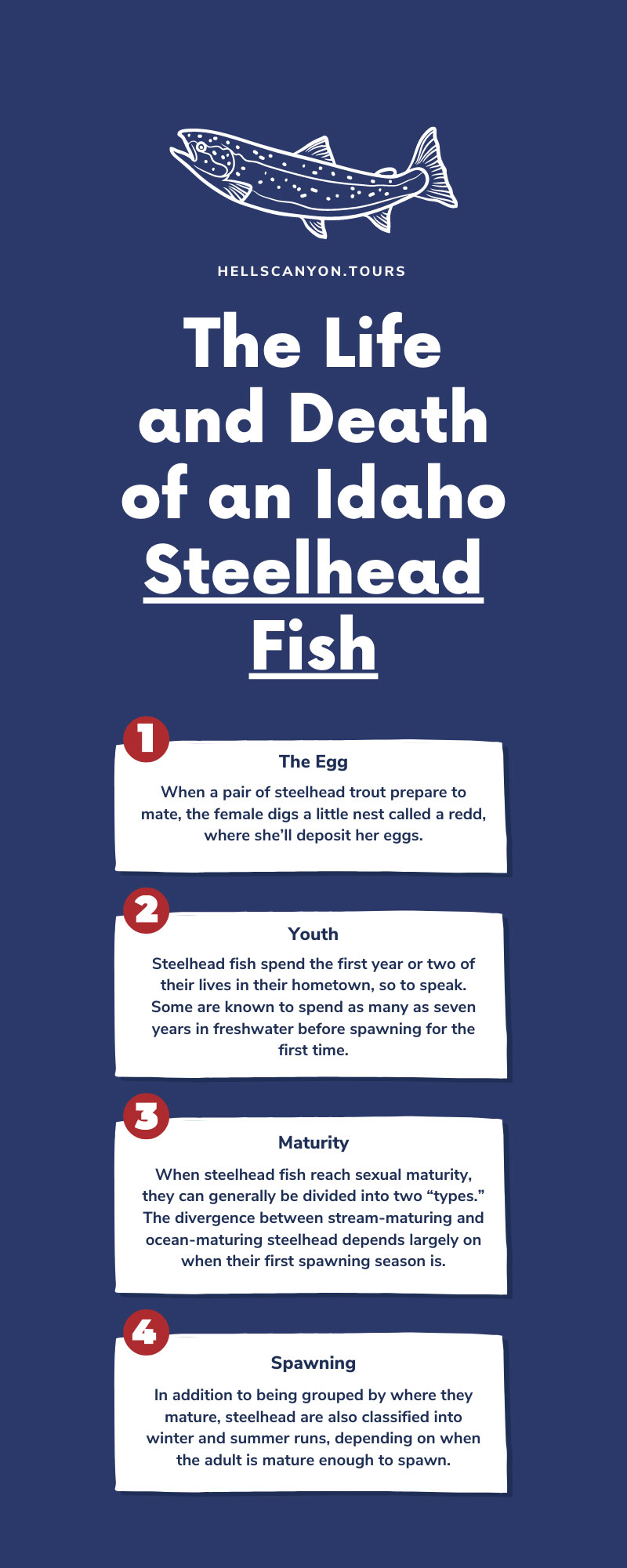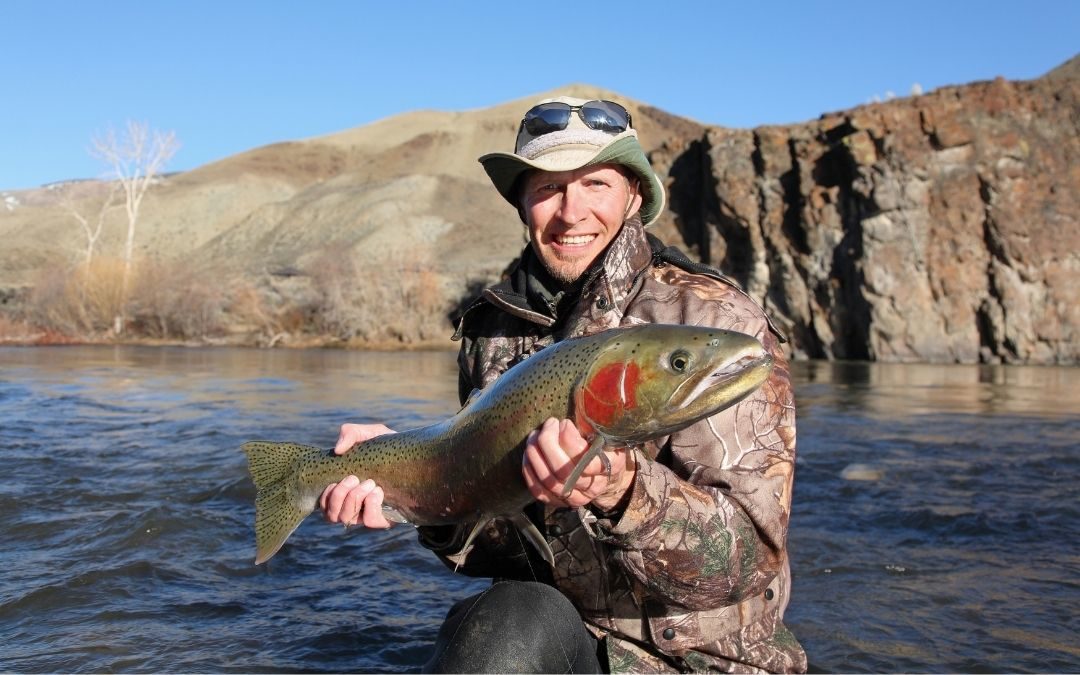When you visit the Hells Canyon area, you’ll find an abundance of steelhead swimming around the nearby Salmon River. Ponder their lifestyle and the circle of life as you reel them in. Their size and coloring tell a story about where they’ve been and where they’re headed. Steelhead trout are the anadromous version of rainbow trout, meaning that they migrate to the sea and back again during spawning season. Between running from freshwater to saltwater and back, what does the life and death of an Idaho steelhead fish look like? Let’s start from the very beginning.
The Egg
When a pair of steelhead trout prepare to mate, the female digs a little nest called a redd, where she’ll deposit her eggs. Meanwhile, the male steelhead fight amongst each other to spawn with their female of choice. Steelhead trout lay their eggs in cold streams and estuaries with plenty of dissolved oxygen and minimal silt or dirt. A female steelhead can lay her eggs in up to four or five tiny nests within her redd, and she’ll keep them between 6 and 14 inches underground. There may be up to 9,000 steelhead eggs in there! The male then fertilizes them, and the female buries the eggs to incubate.
The eggs then take between three and four weeks to hatch. Steelhead fish usually spend the first two or three years of their lives in the freshwater area where they hatched. They’ll call that stream home for the rest of their lives. Steelhead and rainbow trout are genetically the same species; it’s just that lifestyle that’s different. Two steelhead parents can hatch a rainbow trout, and two rainbow trout parents may make a few steelhead.
Youth
Steelhead fish spend the first year or two of their lives in their hometown, so to speak. Some are known to spend as many as seven years in freshwater before spawning for the first time. They remain in the stream or estuarial area where they hatched for those first few years. They eat just about anything, too. Younger, smaller steelhead will feed on zooplankton floating in the water. As their appetites grow along with them, they begin to feed on insects, small mollusks, and crustaceans. They’ve even been known to eat mice!
The steelhead trout grows to an average of 24 inches, but some have been known to reach up to 45 inches! Compare that to the adult rainbow trout, which averages only 16 inches in length. The steelhead’s anadromous (migratory) life cycle beefs it up to a larger size and brings out more vivid colors in its scales. When spawning season comes around, the stripe running along its side becomes a brighter pink or red.
Male steelhead mature at two years, while females reach maturity at three years. Some steelhead do most of their maturing in the ocean before returning to freshwater. Others complete a whole spawning run from freshwater to saltwater and back without spawning at all. And some steelhead migrate gradually, from streams to estuaries to the open sea, stopping at each spot for a year or two before moving on.
Maturity
When steelhead fish reach sexual maturity, they can generally be divided into two “types.” One does most of its growing and maturing in the freshwater where it hatched, and one swims out to the ocean to mature there. The Salmon River, near Hells Canyon, is proud to boast the best steelhead fishing in Idaho, and the river holds fish of all sizes. Steelhead often grow bigger when they mature in the open ocean. After all, they’ve got the space! That maturing process can take three or four years at sea before the fish migrates back home.
The divergence between stream-maturing and ocean-maturing steelhead depends largely on when their first spawning season is. When nature calls the steelhead fish to the ocean, how mature is any particular fish? Is it ready to go on that journey yet? If not, it may stick behind and complete the maturing process in its home stream.
Spawning
In addition to being grouped by where they mature, steelhead are also classified into winter and summer runs, depending on when the adult is mature enough to spawn. Steelhead trout are known for their incredible homing instincts, much like salmon.
But unlike salmon, steelhead can complete multiple spawning runs, going back and forth between freshwater and saltwater for years. The lives of steelhead fish revolve largely around reproduction. In order to reach the ocean and return to their exact home stream or river, they need the power of nature on their side.
A main difference between steelhead and rainbow trout is that homing instinct. Steelhead can detect the chemical profiles of every body of water they swim through, and they remember those chemical profiles. (Think of them like signs along the highway. As the steelhead returns home through the same streams and rivers it used to reach the sea, it will follow the chemical fingerprints that feel familiar.) They also feel the pull of magnetic north and can follow the position of the sun, so there’s no way they’re getting lost!
When the spawning instinct pulls them back home, steelhead trout return to the stream where they hatched, and they begin the process anew. The female steelhead digs a redd much like the one she hatched in herself, and she lays her eggs safely there for the male to fertilize them. Steelhead, unlike salmon, can repeat this process several times throughout their lives. The oldest steelhead caught on record was about 11 years old.
River Adventures’ guided fishing tours will bring you directly to the best steelhead fishing in Idaho. You’ll see steelhead of all different sizes and maturities on the Salmon River near Hells Canyon, and our expert fishing guides will pass on an insider’s knowledge of their life cycle. Since targeted steelhead fishing is prohibited outside steelhead season, a seasoned guide is the way to go. Guess a steelhead’s age by their size and coloring, and take plenty of photos of your experience. The life and death of an Idaho steelhead fish is a fascinating look at the circle of life, from multiple spawning periods to homing instincts. Call River Adventures today for more information about our guided steelhead fishing tours.


Recent Comments